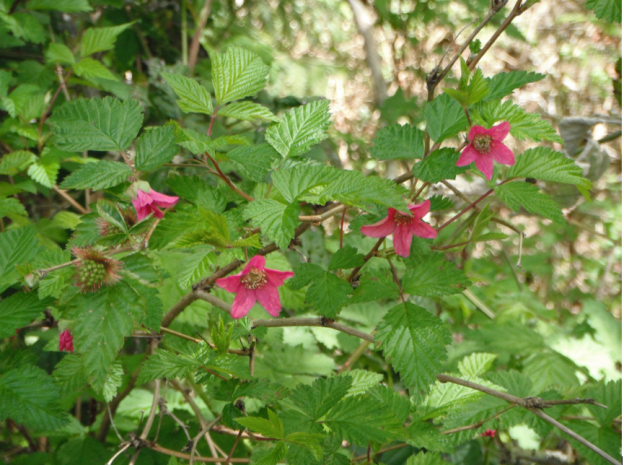Salmonberry The Rose Family—Rosaceae
Rubus spectabilis Pursh.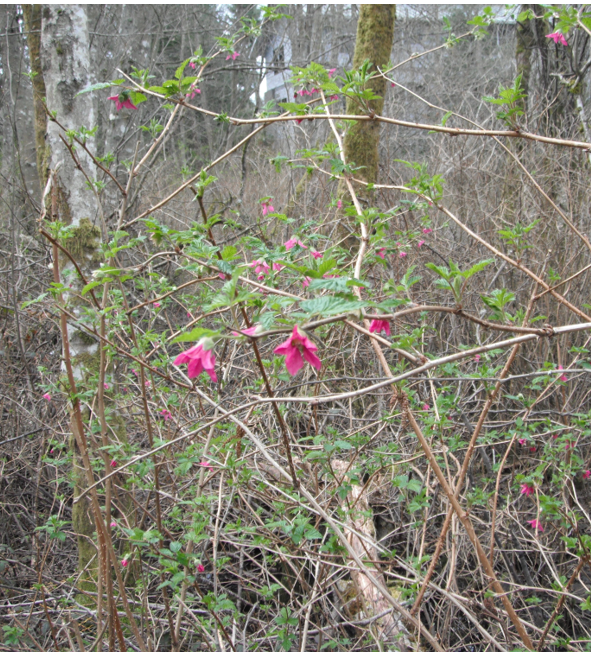
(ROO-bus spek-tah-BIH-lus)
Rubus, derived from ruber, a latin word for red, is the genus of plants generally called brambles. The epithet spectabilis means spectacular due to Salmonberry’s showy flowers and fruits. The common name Salmonberry is thought to have come from the natives’ fondness for eating the berries with salmon roe, but it could also be due to the orangy-pink color of the berries.
Relationships: Rubus is a large genus with between 400 and 750 species. Rubus is considered taxonomically complex due to frequent hybridization and a high degree of polyploidy. It occurs primarily in northern temperate regions, but can be found on all continents, except Antarctica. Many are grown commercially and several cultivated varieties are prized for their large, juicy berries, including Boysenberries, Loganberries, and Marionberries. The berries are actually aggregates of drupelets. There are about 200 species native to North America. In the Pacific Northwest, the three most important native species are Blackcap Raspberry, Salmonberry, and Thimbleberry.
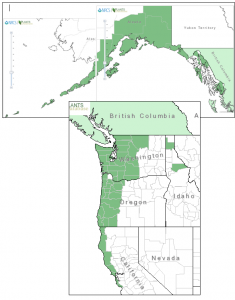
Distribution of Salmonberry from USDA Plants Database
Distribution: Salmonberry is found from southern Alaska to the northern California coast; mostly on the western slope of the Cascades-but it can be found in areas of eastern B.C. and northern Idaho.
Growth: This species grows to 12 feet (4m) from branching rhizomes, forming dense thickets.
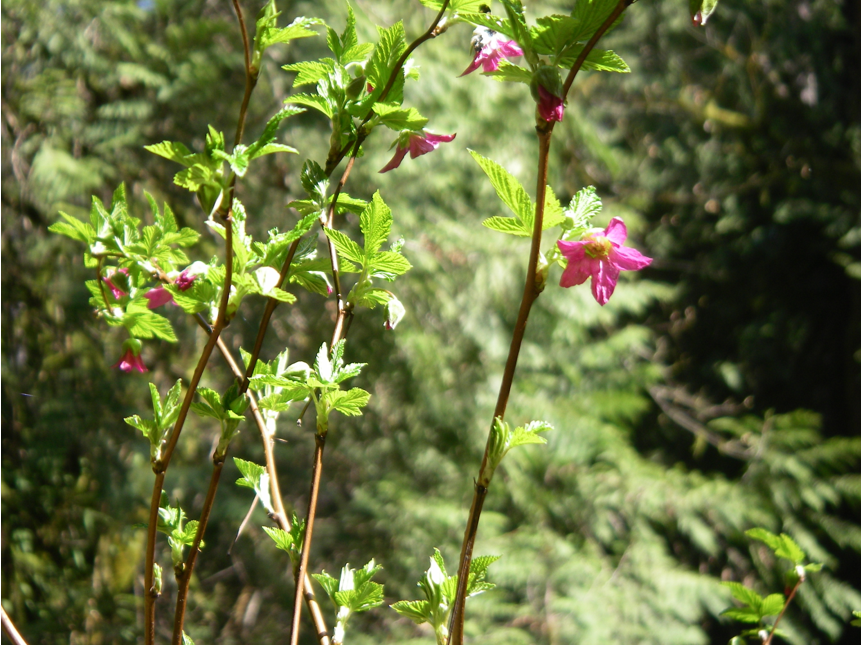
Habitat: It grows in the dappled shade of moist woods and along streambanks. Wetland designation: FAC+, Facultative, it is equally likely to occur in wetlands or non-wetlands.
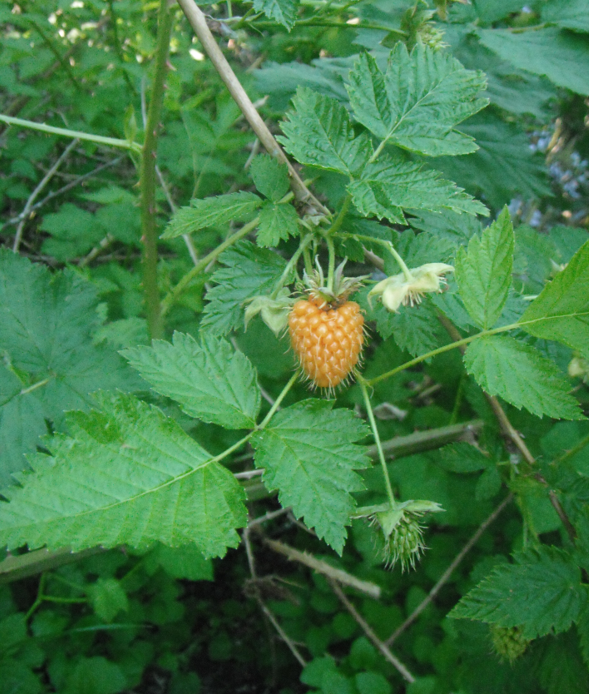 Diagnostic Characters: The arching stems of Salmonberry have golden-brown, shedding bark, similar to Pacific Ninebark. Salmonberry stems, although largely unarmed, can range from having scattered prickles to being very bristly. Smaller twigs zigzag slightly from node to node. Leaves have 3 sharply toothed leaflets, the lateral ones smaller and sometimes unequally lobed or divided. Five-petalled flowers are a striking pink to reddish-purple. The fruits are raspberry-like with a hollow core, ranging from yellow to orange-red.
Diagnostic Characters: The arching stems of Salmonberry have golden-brown, shedding bark, similar to Pacific Ninebark. Salmonberry stems, although largely unarmed, can range from having scattered prickles to being very bristly. Smaller twigs zigzag slightly from node to node. Leaves have 3 sharply toothed leaflets, the lateral ones smaller and sometimes unequally lobed or divided. Five-petalled flowers are a striking pink to reddish-purple. The fruits are raspberry-like with a hollow core, ranging from yellow to orange-red.
In the landscape: Although it has attractive flowers and fruits, Salmonberry is best delegated to the wild garden due to its prickly, thicket-forming habit. It is a great choice for wetland restoration projects.
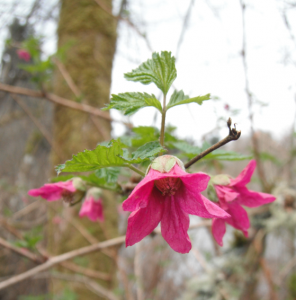 Phenology: Bloom time: April-May. Fruit ripens: May-July.
Phenology: Bloom time: April-May. Fruit ripens: May-July.
Propagation: Stratify seeds warm for 90 days then cold at 40º F (4º C) for 90 days. Scarification of the seed with sulfuric acid or sodium hyperchlorite prior to stratification may improve germination rates. Salmonberry is easily propagated by cuttings, layering or division. Remaining stumps or underground rhizomes quickly resprout new growth after a fire or other disturbance.
Use by People: Salmonberries, being one of the earliest berries to ripen, were one of the most important foods for natives. The berries are too watery to dry, so were usually eaten fresh in oolichan grease or with salmon or salmon eggs. Reports vary on the berries’ flavor from “insipid” or “inferior” to “juicy with a very good flavor” or “tasty.” It is likely that differences in taste are due to variations within the species or the relative ripeness of each berry. Today the berries are sometimes made into jams, jellies, candy, or wine. Young sprouts were also an important food for natives in early spring and summer; they were peeled, eaten raw or steamed. Preparations of the bark were used on wounds, especially burns.

Use by Wildlife: The pinkish-purple flowers of Salmonberry are attractive to Rufous Hummingbirds as they are migrating north. The brambles rank at the very top of summer foods for wildlife, especially birds: grouse, pigeons, quail, grosbeaks, jays, robins, thrushes, towhees, waxwings, sparrows, to name just a few. The berries are also popular with raccoons, opossums, skunks, foxes, squirrels, chipmunks and other rodents. The leaves and stems are eaten extensively by deer and rabbits. Bear, beaver and marmots eat fruit, bark and twigs. Flowers are usually pollinated by insects. These usually prickly plants make impenetrable thickets where small animals find secure cover.
Links:
Consortium of Pacific Northwest Herbaria
WTU Herbarium Image Collection, Plants of Washington, Burke Museum
E-Flora BC, Electronic Atlas of the Flora of British Columbia
Jepson Eflora, University of California
Ladybird Johnson Wildflower Center
USDA Forest Service-Fire Effects Information System
Virginia Tech ID Fact Sheet
Native Plants Network, Propagation Protocol Database
Native American Ethnobotany, University of Michigan, Dearborn

